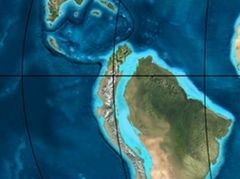Santa Lucía Formation
| Santa Lucía Formation | |
|---|---|
| Stratigraphic range: Maastrichtian-Paleocene | |
| Type | Geological formation |
| Unit of | Potosí Basin |
| Underlies | Cayara Formation |
| Overlies | El Molino Formation |
| Thickness | 381.35 m (1,251.1 ft) |
| Lithology | |
| Primary | Shale, marl |
| Other | Siltstone |
| Location | |
| Coordinates | 18°00′46.0″S 65°24′23.4″W / 18.012778°S 65.406500°W |
| Region | Cochabamba |
| Country | |
| Type section | |
| Location | Tiupampa, Mizque |
| Coordinates | 18°00′46.0″S 65°24′23.4″W / 18.012778°S 65.406500°W |
| Approximate paleocoordinates | 20°42′S 52°30′W / 20.7°S 52.5°W |
 Paleogeography of Northern South America 65 Ma, by Ron Blakey | |
The Santa Lucía Formation is a Maastrichtian to Paleocene (Danian) geologic formation in Bolivia. Fossil ornithopod tracks have been reported from the Cretaceous lower part of the formation.[1] It is the type formation of the Tiupampan South American land mammal age.
Description
The Santa Lucía Formation is a formation of the Potosí Basin in Bolivia dated to the Paleocene, 60 to 58.2 Ma.[2] It overlies the Cretaceous El Molino Formation and is overlain by the Cayara Formation. The formation is laterally equivalent with the Maíz Gordo Formation of northern Argentina,[3] and time-equivalent with the Salamanca Formation of Argentina, the Maria Farinha Formation of the Paraíba Basin in northern Brazil and the Guaduas Formation of the Altiplano Cundiboyacense and fossiliferous Cerrejón Formation of the Cesar-Ranchería Basin, Colombia.
The 381.35 metres (1,251.1 ft) thick formation consists of reddish sandy shales, marls and siltstones deposited in a fluvial to lacustrine environment.[4][5]
Fossil content
The fossiliferous formation has provided the following fossils:
See also
References
- ^ Weishampel, et al., 2004, pp.517-607
- ^ Sempere et al., 1997, p.709
- ^ Sempere et al., 1997, p.712
- ^ Jiménez, 2012, p.11
- ^ Renner & Velasco, 2000, p.25
- ^ a b c Gayet et al., 1991, p.403
- ^ a b c Tiupampa 1 at Fossilworks.org
- ^ Buffetaut & Marshall, 1991
- ^ Rage, 1991a, pp.499-501
- ^ Rage, 1991b, pp.503-508
Bibliography
- Buffetaut, E., and L.G. Marshall. 1991. A new crocodilian, Sebecus querejazus, nov. sp. (Mesosuchia, Sebecidae) from the Santa Lucía Formation (Early Paleocene) at Vila Vila, Southern Bolivia, 545–557. Revista Técnica de YPFB.
- Gayet, Mireille; Larry G. Marshall, and Thierry Sempere. 1991. The Mesozoic and Paleocene vertebrates of Bolivia and their stratigraphic context: a review. Revista técnica de YPFB 12. 393-433. Accessed 2017-08-15.
- Jiménez, Grisel. 2012. Estratigrafía, facies y ambientes evolutivos de depósito del Paleógeno Inferior: Formación Santa Lucía (Sinclinal de Miraflores - Sección Cayara, Potosí), 1-23. .. Accessed 2017-08-15.
- Rage, J.C.. 1991a. Gymnophionan Amphibia from the early Paleocene (Santa Lucía Formation) of Tiupampa (Bolivia). The oldest known Gymnophiona. Revista técnica de YPFB 12. 499-501. Accessed 2017-08-15.
- Rage, J.C.. 1991b. Squamate Reptiles from the early Paleocene of Tiupampa area (Santa Lucía Formation), Bolivia. Revista técnica de YPFB 12. 503-508. Accessed 2017-08-15.
- Renner, Sven, and Carlos Velasco. 2000. Geología e hidrogeología del Valle Central de Cochabamba. Boletín del Servicio Nacional de Geología y Minería 34. 1-113. Accessed 2017-08-15.
- Sempere, Thierry; R.F. Butler; D.R. Richards; L.G. Marshall; W. Sharp, and C.C. Swisher. 1997. Stratigraphy and chronology of Upper Cretaceous-lower Paleogene strata in Bolivia and northwest Argentina. GSA Bulletin 109. 709-727. Accessed 2017-08-15.
- Weishampel, David B.; Peter Dodson, and Halszka Osmólska. 1991. The Dinosauria, 1-861. Berkeley: University of California Press.
- Geologic formations of Bolivia
- Cretaceous Bolivia
- Paleogene Bolivia
- Paleontology in Bolivia
- Fossiliferous stratigraphic units of South America
- Tiupampan
- Peligran
- Shale formations
- Fluvial deposits
- Lacustrine deposits
- Maastrichtian Stage
- Danian Stage
- Cretaceous–Paleogene boundary
- Geography of Cochabamba Department

